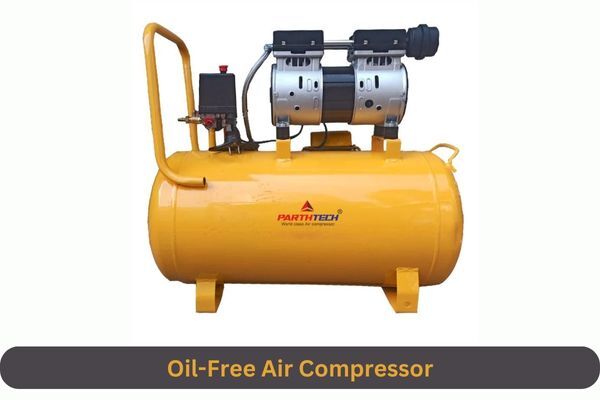-
Call
-
Whatsapp
9825014048
-
Location


Blog


BLOG

Oil-free air compressor
In industrial applications, choosing an air compressor is a critical decision that directly impacts productivity, efficiency, and overall operational costs. Oil-free air compressors have gained immense popularity for their clean and contaminant-free air supply, making them essential for industries where compressed air quality is paramount.
This detailed guide will go over all the essential considerations to help you choose the best oil-free air compressor for your business.
Understanding the Importance of Oil-Free Compressed Air:
The danger of oil contamination in the compressed air stream is eliminated by designing oil-free air compressors, making them indispensable in pharmaceuticals, food and beverage, electronics, and healthcare industries. The absence of oil ensures a pure and uncontaminated air supply, safeguarding sensitive processes, machinery, and end products from potential damage.

Key Consideration for Selection:
1. Air Quality Requirements:
Understand the specific air quality standards required for your industrial processes. Different applications may have varying degrees of sensitivity to contaminants, and selecting an oil-free compressor that meets or exceeds this standard is crucial.
2. Capacity and Air Pressure:
Evaluate the compressed air requirements of operations, considering both volume (CFM- Cubic Feet Per Minute) and pressure (PSI- Pounds per square inch). Ensure the selected compressor can meet the requirements.
3. Application Specific Features:
Identify any unique features or specifications needed for your applications. For Instance, some industries may require less maintenance than oil-lubricated counterparts, and understanding routine service needs and costs is crucial for long-term operational efficiency.
4. Energy efficiency:
Opt for energy-efficient models to minimise operational costs and reduce environmental impact. Variable speed drives and advanced control systems can contribute significantly to energy savings.
5. Maintenance Considerations:
Assess the maintenance requirements of different oil-free compressors. While they generally require less maintenance than oil-lubricated counterparts, understanding routine service needs and costs is crucial for long-term operational efficiency.
6. Compressor Type:
Select the appropriate type of oil-free compressor rotary screw, reciprocating, or centrifugal, based on your specific application needs. Each type has advantages and limitations, so understanding the nuances is vital for optimal performance.
7. Footprint and Installation Requirements:
Consider the available space and installation requirements. Some compressors may have a smaller footprint or be designed for easy integration into existing systems, facilitating a smoother installation process.
Conclusion:
Choosing the suitable oil-free air compressor for your industrial applications is a strategic decision that requires a thorough understanding of your specific needs. By considering factors such as air quality requirements, capacity, application-specific features, maintenance, energy efficiency, and compressor type, you can make a well-informed choice after considering installation that meets and exceeds your operations' compressed air demands. Invest the time and effort in selecting the suitable compressor, and you'll undoubtedly witness enhanced efficiency, reliability, and overall productivity in your industrial processes.


FAQs

Frequently Ask Questions
Oil-free air compressors ensure a contaminant-free air supply, making them essential for industries with stringent air quality requirements, such as pharmaceuticals, food and beverage, electronics, and healthcare.
The specific air quality standards depend on the sensitivity of your processes. Consult industry guidelines and regulatory requirements to determine the appropriate application standards.
Evaluate your machinery and tools' compressed air requirements regarding volume (CFM) and pressure (PSI). Consult equipment specifications and consider future expansion needs to determine the appropriate capacity.
The main types are rotary screws, reciprocating, and centrifugal compressors. Each has its advantages and limitations. Consider the most suitable application type for efficiency, capacity, and maintenance requirements.
Identify application-specific features such as variable speed drives for energy efficiency, high-capacity receivers for consistent air supply, or any other unique requirements relevant to your industrial processes.
Opt for models with energy-efficient features like variable speed drives and advanced control systems. Understanding the compressor's energy consumption and efficiency ratings is crucial for minimising operational costs.
While oil-free compressors generally require less maintenance, it's essential to understand routine service needs and costs. Regular maintenance is necessary for the compressor to last as long as possible and work at its best.
Consider the available space and installation requirements. Some compressors have smaller footprints or are designed for easy integration into existing systems, facilitating a smoother installation process.
Retrofitting depends on various factors, including the existing system's compatibility, space availability, and specific requirements. To determine whether retrofitting is feasible for your situation, consult with an expert.
Consider initial costs, energy efficiency, maintenance requirements, and expected lifespan to calculate the total cost of ownership over the compressor's operational life. This comprehensive approach ensures a more accurate assessment of long-term costs.
